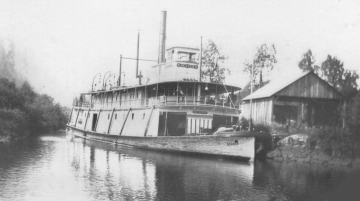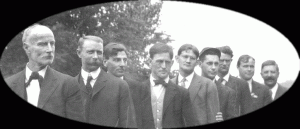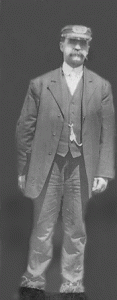The Beaver Commissioned February 10, 1906
The new river steamer, of Clatskanie Transportation company, was launched in Portland Saturday afternoon, and when equipped will go into the Clatskanie trade.
The Beaver is 153 feet long, 30 feet beam and her hold has a depth of six feet. She is flat bottomed and can handle large cargos at low stage of water.
Capt. Victor Degerstedt will be in command and the new boat will go into commission in about two weeks.

Photo of the Steamer Beaver taken at the Kratz mill at Clatskanie, OR ca 1908
Pictures from the collection of W. Kunz reproduced by permission.

Group photo of the officers of the Beaver
Left to right: Captain Davis, pilot; C. Frederickson, First A. Engineer; R. M. Mack, Purser; H. Wagner, First Officer; J. S. Van Horn, First Clerk; R. A. Merry, Steward; R. Cunningham, Watchman; E. E. Cellings, Chief; and V. Degerstedt, Captain.
[editor’s note: picture was taken on an excursion up the Lewis River in Washington circa 1908, that may explain the presence of Capt. Davis whose home was located on the Lewis River.]
Thursday, June 12, 1913
STOCK TAKEN TO SAFETY STEAMER BEAVER OF CLATSKANIE, DOES WORK 76 HEAD HUDDLED TOGETHER LITTLE DIFFICULTY EXPERIENCED IN GETTING ANIMALS ABOARD, THEY SEEMING TO REALIZE DANGER.
A special trip was made Saturday [June 7, 1913] by the river steamer Beaver from Clatskanie to La Du’s [place] to take 60 head of cattle and 16 head of horses from the inundated land there to Carroll’s Point. Captain Victor Degerstedt resumed his regular trip to Oak Point after the stock had been moved.
Officers of the steamer say that eight calves in the herd had to swim from the small parcel of high ground on which they had taken refuge, to the steamer. Little difficulty was experienced in getting the cattle aboard the steamer, as they seemed to realize that it was their only means of escape from the rising waters. The calves needed practically no urging to take the water to the steamer, and there was little difficulty with the other stock, although the water came up to their backs, and the entire lot was loaded in about an hour’s time.
Practically all of the steamers plying on the lower river have had to move more or less stock to places of safety during the past few days.
Thursday, September 25, 1913
STEAMER BEAVER IS STRANDED STRIKES SNAG WHILE LEAVING CLATSKANIE WEDNESDAY EVENING REPAIRS BEING MADE GASOLINE LAUNCH WAKENA WILL TAKE THE RUN UNTIL BOAT IS ABLE TO GO AGAIN ON HER REGULAR RUN.
The river steamer Beaver struck a submerged snag and tore a hole in her hull on the starboard side near the bilge and opposite the boiler and was at once beached last Wednesday [September 24, 1913] at 2 p.m. at Clatskanie, about two hundred feet from the draw bridge. The damaged part of her hull is eight feet long and the size of several planks.
Captain Vic Degerstedt, master of the steamer and who is interested in the Clatskanie Transportation Company, which owns the vessel, was in charge at the time. The Beaver was fully loaded with shingles and furniture and was bound for Portland.
Immediately after the accident, when it was apparent that the hull was filling, Captain Degerstedt headed her for the beach and managed to strike an easy resting place, where her bow is out of water and the stern submerged about five feet. The depth of water there is close to 16 feet.
The Beaver is one of the best known of the river fleet and she has been on the Clatskanie-Portland route since she was built in 1906. The vessel is 152 feet long by 31 foot beam and 6.5 feet depth of hold. When a report of the accident was made to officials of the line here it was arranged that Captain James. W. Shaver and D. C. O’Reilly proceed to Clatskanie today and attend to the work of raising her. It was decided also to place the gasoline barge Wakena on the run during the period the Beaver is undergoing repairs.
Thursday, June 19, 1919
“BLACK FRIDAY” IS AGAIN RECALLED
“Black Friday,” June, 13th, [1919], was not found wanting in measuring up to the superstitious sailor tradition of being a most unlucky day when Ben Pavlick, age 22, stumbled and plunged from the lower deck of the Steamer “Beaver” into the Columbia river just after the boat had left the landing at this place [Rainier] last Friday evening.
Young Pavlick was an expert swimmer and it was thought that he would reach the shore safely and there was perhaps just a little time lost aboard the Steamer “Beaver” by the crew in getting a life boat off because of this fact. Mr. Pavlick had reached a position about 20 yards opposite the “Eadem” dock when he swam into an eddy and gave up at once. Whether he was afflicted with cramps or had worn himself out battling with the strong current of the river will never be known. He was seen to suddenly throw his head back and sink. Several boats had by this time got to the place, but the body did not come to the surface again.
The Steamer “Beaver” reversed her engines as soon as the alarm of man overboard was sounded, but being a large boat and the current of the river being exceptionally strong at this time of the year, she was unable to back up to assist young Pavlick.
The Beaver remained tied up here for some time and her crew dragged the river with several boats but they failed to locate the body.
The place where Mr. Pavlick went down is regarded as dangerous and uncanny by rivermen. It is almost the same place where a man was knocked off the deck of the Steamer “Joseph Kellog” four years ago and the body was never recovered. It is thought that undercurrents or cross currents may be responsible for the disappearance of the bodies.
Friday, September 9, 1927
“BEAVER” ON NEW RUN BOAT WELL KNOWN LOCALLY TO PLY UPPER RIVER
The steamer “Beaver,” which was taken off the Portland- Clatskanie run last summer, will ply the upper river, according to plans of the Harkins Transportation company, owners of the boat. The Beaver has been remodeled and it is expected that it will be placed on the new run late this week.
THE END OF THE STERNWHEELER “BEAVER”
Lawrence Barber, of the Oregonian, ca 1960, in an article about the Shaver family, reported that the steamer “Beaver” in 1935 struck a rock and sank near the Canoe Encampment rapids on the upper Columbia river.
ABOUT CAPTAIN VICTOR DEGERSTEDT

According to Lynn Degerstedt, nephew to Capt. Victor Degerstedt, Victor left home at Skelleftea, Sweden, at the age of 16, and went to sea. The family was not to hear from him for two years.
By the time he returned to his family Victor had traveled three times around the world. In all he was to travel around the world eight times and could relate wonderful stories of adventure on the high seas.
Victor decided to come to America and arriving in Portland, Oregon, put his skills to work on the river. He married Mary Frank and they had a daughter, Frances. Their home was on North Borthwick in the Albina district.
Victor started the Clatskanie Transportation Company and commissioned the sternwheeler “Beaver” in 1906. Later he added to his holdings with the “Wakena” a gasoline powered barge which he designed as a shallow draft boat that could service the waters of the tributaries and sloughs of the Columbia.
In the middle 1920’s river transportation became a sad third in competition with the railroads and the newly built Columbia River highway. Under the pressure of declining business and the oncoming financial depression Victor sold the company and bought a park on the Clackamas river near the small community of Barton.
Picture from the collection of W. Kunz reproduced by permission.
(original picture digitally edited to isolate Capt. Degerstedt.)
